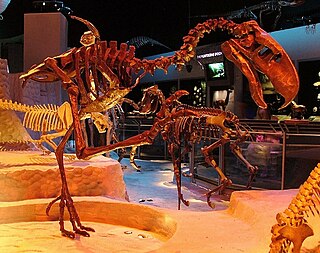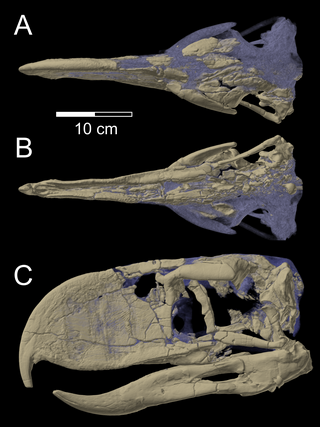
Rheidae is a family of flightless ratite birds which first appeared in the Paleocene. It is today represented by the sole living genus Rhea, but also contains several extinct genera.

Phorusrhacids, colloquially known as terror birds, are an extinct family of large carnivorous flightless birds that were among the largest apex predators in South America during the Cenozoic era; their conventionally accepted temporal range covers from 53 to 0.1 million years (Ma) ago.

Vegavis is a genus of extinct bird that lived during the Late Cretaceous of Antarctica, some 68 to 66 mya. Among modern birds, most studies show that Vegavis is most closely related to ducks and geese (Anatidae), but it is not considered to be a direct ancestor of them, although other studies question these results.

Mycteria is a genus of large tropical storks with representatives in the Americas, east Africa and southern and southeastern Asia. Two species have "ibis" in their scientific or old common names, but they are not related to these birds and simply look more similar to an ibis than do other storks.

Andalgalornis is a genus of flightless predatory birds of the extinct family Phorusrhacidae that lived in Argentina. The type and only species is A. steulleti.

Brontornis is an extinct genus of giant bird that inhabited Argentina during the Early to Middle Miocene. Its taxonomic position is highly controversial, with authors alternatively considering it to be a cariamiform, typically a phorusrhacid or an anserimorph.
Megapaloelodus is an extinct genus of stem flamingo of the family Palaelodidae. Megapaloelodus is primarily known from Miocene America, from South Dakota and Oregon in the north to Argentina in the south, but the species Megapaloelodus goliath was found in Europe. Additionally, one unnamed species was discovered in Miocene sediments from Namibia. Due to a lack of skull material, little can be said about the ecology of Megapaloelodus. Species of this genus are typically larger than those of Palaelodus and appear to have inhabited similar brackish lake environments. Additionally, they may have been capable of "locking" their legs in a standing position.

Mesembriornis is a genus of intermediate-sized phorusrhacids that grew up to 1.5 metres (4.9 ft) in height. They represent a well-distinct lineage of terror birds, differing from the massive large groups and the smaller Psilopterinae. In general proportions, they most resembled the Patagornithinae which flourished somewhat earlier, mainly to the south of the range of Mesembriornis. Fossils of the terror bird have been found in Montehermosan deposits of the Monte Hermoso Formation, as well as the Andalgala Formation and Chapadmalal Formation in Argentina.

Kelenken is a genus of phorusrhacid, an extinct group of large, predatory birds, which lived in what is now Argentina in the middle Miocene about 15 million years ago. The only known specimen was discovered by high school student Guillermo Aguirre-Zabala in Comallo, in the region of Patagonia, and was made the holotype of the new genus and species Kelenken guillermoi in 2007. The genus name references a spirit in Tehuelche mythology, and the specific name honors the discoverer. The holotype consists of one of the most complete skulls known of a large phorusrhacid, as well as a tarsometatarsus lower leg bone and a phalanx toe bone. The discovery of Kelenken clarified the anatomy of large phorusrhacids, as these were previously much less well known. The closest living relatives of the phorusrhacids are the seriemas. Kelenken was found to belong in the subfamily Phorusrhacinae, along with for example Devincenzia.

Devincenzia is an extinct genus of giant flightless predatory birds in the family Phorusrhacidae or "terror birds" that lived during the Early Miocene (Deseadan) Fray Bentos Formation of Uruguay and Late Miocene (Huayquerian) Ituzaingó Formation to Early Pliocene (Montehermosan) of Argentina. The type species D. pozzi was formerly known as Onactornis pozzi. It stood about 2.5 metres (8.2 ft) tall, making it one of the largest Phorusrhacids and carnivorous birds known.

Patagornis is a genus of extinct flightless predatory birds of the family Phorusrhacidae. Known as "terror birds", these lived in what is now Argentina during the Early and Middle Miocene; the Santa Cruz Formation in Patagonia contains numerous specimens. Patagornis was an agile, medium sized Patagornithine and was likely a pursuit predator.

Procariama is an extinct monotypic genus of phorusrhacid, which lived from the Late Miocene to the Late Pliocene of Argentina. Fossils of the animal have been found in six places, in the Cerro Azul and Andalhuala Formations. More specifically in the Andagalá department and in the north of the Belén department of the Catamarca province, with a single location in the La Pampa province. The type and only species, Procariama simplex, is the largest member of the subfamily Psilopterinae.

Psilopterus is an extinct genus of phorusrhacid from the Middle Oligocene to possibly the Late Pleistocene of Argentina and Uruguay. Compared to other phorusrhacids, members of the genus are both relatively gracile and diminutive, and include the smallest known species of terror bird: with the head raised P. bachmanni was 70–80 centimeters (2.3–2.6 ft) in height and weighed about 5 kilograms (11 lb), while the largest members of the genus were only about 8 kilograms (18 lb). The birds resemble the modern cariama, except with a heavier build and considerably smaller wings. The strong morphological similarity between the claws of the predatory cariama and Psilopterus, both of which are sharp, curved, and laterally compressed, may indicate they were used to strike prey. Tonni and Tambussi also suggested that, in contrast to the other, larger terror birds, Psilopterus could use their claws to climb trees, and could even fly, but this has been rejected in more recent literature. Fossil finds in Uruguay indicate the genus may have survived until 96,040 ± 6,300 years ago, millions of years after the larger phorusrhacids became extinct.

Eleutherocercus was a genus of glyptodonts that lived during the Late Miocene and Early Pliocene in South America. Fossils of the genus have been found in the Huayquerian Ituzaingó Formation and the Montehermosan Monte Hermoso Formation in Argentina.
Macranhinga is a genus of extinct darters belonging to the Anhingidae. The type species is M. paranensis, which was described on the basis of complete tarsometatarsi and several dissociated skeletal elements. All the specimens come from the Ituzaingó Formation that crops out discontinuously along the eastern cliffs of the Paraná River in northeastern Argentina, the river from which the specific epithet is derived. The most striking feature of this bird is its large size, much greater than in all other known fossil or extant anhingas.
The Ituzaingó Formation, in older literature also described as Entre Ríos or Entrerriana Formation, is an extensive geological formation of Late Miocene age in the Paraná Basin of the Corrientes, Santa Fe and Entre Ríos Provinces in Mesopotamia, northeastern Argentina. The formation comprises mudstones, cross-bedded sandstones and conglomerates deposited in a fluvio-deltaic environment and is renowned for the preservation of a rich fossil assemblage, including many mammals, birds, reptiles, fish, bivalves, foraminifera, ichnofossils and flora.
Chunga incerta is an extinct species of cariamid bird which inhabited the Pliocene of the central-eastern Southern Cone of South America. It belongs to the genus Chunga, today only represented by one species, Chunga burmeisteri.
Patagorhacos is an extinct genus of medium-sized phorusrhacid from the early Miocene of Patagonia. Currently only the single species Patagorhacos terrificus is known, which is represented by two highly fragmentary specimen, one belonging to the back of the skull and the other being the distal end of a leg bone. It was described together with the contemporary rheid Opisthodactylus horacioperezi.

Ortotherium is a genus of megalonychid ground sloth from the Late Miocene Ituzaingó Formation of Entre Rios Province, Argentina. Although many species were described, the only valid species of the genus is Ortotherium laticurvatum, with many species being junior synonyms. Ortotherium is known from very fragmentary material, all of which is material from the mandible and teeth. The holotype of O. laticurvatum consists of an incomplete left dentary that had been unearthed from a series of sediments known as ‘Conglomerado osifero’ in Paraná, Argentina. Argentina paleontologist Florentino Ameghino named the species in 1885, though he would go on to name four more, invalid, species of the genus. One species however, O. brevirostrum, has been reclassified as Mesopotamocnus.
The Paraná Formation is a geologic formation in Argentina. It preserves fossils dating back to the late Miocene epoch.













